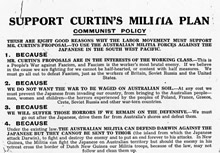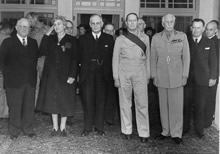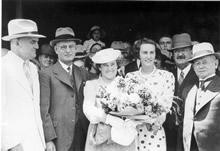
Curtin becomes Prime Minister
John Curtin became Prime Minister on 7 October 1941, just two months before Japanese forces attacked the American naval base at Pearl Harbour. After Japan invaded the British naval base at Singapore, taking thousands of British and Australian troops captive, Curtin spent the early months of 1942 demanding, and finally getting, the Sixth and Seventh Divisions of the AIF returned from the Middle East to fight advancing Japanese forces in New Guinea and the Pacific.
He encouraged American forces, led by General Douglas MacArthur, to use Australia as a base from which to launch a counter attack to win the war.
 Curtin Government after Swearing In, October 1941.
Curtin Government after Swearing In, October 1941.
Records of the Curtin Family. JCPML00376/115
Defence (Citizen Military Forces) Bill
When Curtin became Prime Minister, conscription for service in the militia was already in place, having been introduced by Menzies at the beginning of the war. In 1942, under threat of Japanese invasion, Curtin had to face his greatest challenge - and the action that generated the most criticism of him as a betrayer of his revolutionary roots - extending conscription of men for military service to the overseas theatre of war. Australia had two armies: the Australian Imperial Force (AIF), recruited to fight overseas and composed entirely of volunteers, and the partly-conscripted Australian Military Force (AMF), also known as the militia. Curtin was uncomfortable with the fact that American conscripts were dying while fighting in Australia's defence, and he felt that Australia's insistence on retaining conscripts at home was insupportable.
Curtin introduced the issue of conscription for overseas military service at a Special Conference of the ALP in Melbourne in November 1942. Although Lloyd Ross [54] stated that Curtin undertook no prior lobbying, his intentions were certainly foreshadowed in his speech to the WA State Executive the previous month. Fearing the prospect of splitting the Party, he followed the correct ALP policy procedure by seeking a ruling on the issue by the Party's decision-making body before introducing legislation in Parliament. Curtin's proposal was passed at a Special Conference in January 1943 - with WA being one of the States to vote in favour. Curtin then introduced in Parliament the Defence (Citizen Military Forces) Bill under which members of the militia (including conscripts) could be required to serve in any area of General MacArthur's command in the South West Pacific Zone.
Although the UAP Opposition had long been calling for the removal of any territorial limitations for the militia, when Curtin introduced the Bill, UAP members finally yielded to the extent of requiring the militia to serve in the South-West Pacific, he was criticised from both sides of the House. Curtin justified his timing of the Militia Bill by saying that his government's policy had not 'impaired the efficient use of the [fighting forces] by the Commander in Chief [General MacArthur]'.
Among Labor ranks, Arthur Calwell, Don Cameron, Eddie Ward and Maurice Blackburn most strongly opposed conscription for overseas service. In a Caucus meeting on 24 March, Calwell accused Curtin of being a turncoat and said that he would 'finish up to the other side leading a Nationalist Government'. Curtin threatened to resign and Calwell was forced to apologise. Curtin's old friend, H.E. Boote, launched a savage attack against him on the front page of the Australian Worker. This must have been particularly hard for Curtin to bear, as Boote was one of a select group of friends that he had maintained since his youth. He depended on these friends to reassure him that 'his present role was in accord with his earlier international socialist beliefs'. [55]
 Flyer, Support Curtin's Militia Plan, n.d.
Flyer, Support Curtin's Militia Plan, n.d.
Records of Arthur Calwell.
Original held by National Library of Australia, MS 4738, Series 7, box 24, folder: ALP and anti-conscription 1942-43-46.
JCPML00651/3
 War leadership, 8 June 1943.
War leadership, 8 June 1943.
L-R US Ambassador Nelson Johnson, Lady Gowrie,
PM John Curtin, Gen Douglas MacArthur,
Lord Gowrie and Deputy PM Frank Forde.
Records of the Curtin Family.
JCPML00376/73
Curtin and the Western Australian ALP
As Party Leader and then Prime Minister, Curtin did not always enjoy a harmonious relationship with the WA Branch of the Party. In January 1941, he was involved in accusations by the Labor candidate for Swan, James Dinan, that the State Executive had 'sabotaged' his election chances. A victory in the Swan by-election, held in December 1940, following the death of the sitting Member, Country Party member Henry Gregory, would have gained Labor a majority in the House of Representatives and enabled Curtin to form government. What should have been a top priority campaign became a fiasco. The Federal Budget was being debated in the House of Representatives, and Curtin, under pressure from Caucus to exploit the precarious situation of the UAP Government, could not devote any time to the campaign. [56]
Other tensions arose over the defence of Western Australia, after Japanese aircraft attacked Derby, Wyndham and Broome early in 1942. American forces did not begin arriving until the middle of the year and the munitions industry was established at Midland and Welshpool only in 1943. [57] Nevertheless, the landslide victory that Curtin and Labor enjoyed in WA, as well as in the rest of Australia, in August 1943, suggested that these disagreements were forgotten. Curtin won Fremantle by a majority of almost 23,000 votes. [58]
Curtin spent very little of his last year of life in Western Australia. He and Elsie visited the United States and Britain from April to June, 1944. In October, during two weeks 'holiday' in Perth, Curtin addressed children at a state school in his electorate, urging them to build 'a bigger and better Australia'. [59]
After several months of illness, he died in Canberra on 5 July 1945. The ALP WA State Secretary, Tom Davies, honoured him with these words: 'John Curtin is dead, but the memory of a great Australian, a great Labour leader, a great democrat and a great man will live so long as Australian history endures'. [60]
 Dr T Meagher, John Curtin, Elsie Curtin, daughter Elsie, John Willcock, E Needham at Perth railway station, 24 January 1942.
Dr T Meagher, John Curtin, Elsie Curtin, daughter Elsie, John Willcock, E Needham at Perth railway station, 24 January 1942.Records of the Curtin Family.
JCPML00382/58
 John Curtin addressing pupils at Kent Street State School, Victoria Park, October 1944.
John Curtin addressing pupils at Kent Street State School, Victoria Park, October 1944.
Records of the West Australian News Ltd.
JCPML00409/16.